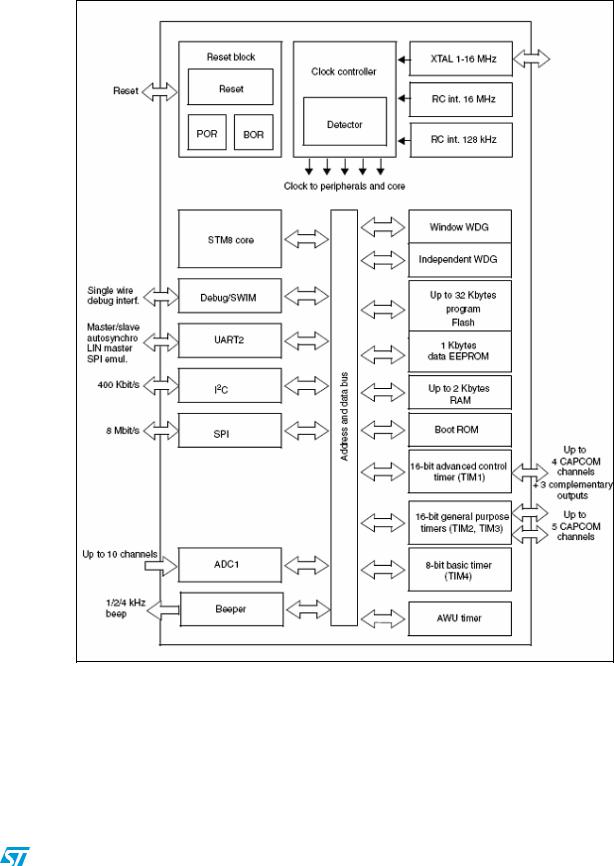
- •Figure 1. STM8S-DISCOVERY evaluation board
- •1 Quick start
- •2 Hardware and layout
- •Figure 2. Hardware block diagram
- •Figure 3. Top layout
- •2.1 STM8S105C6T6 microcontroller
- •Figure 4. STM8S105C6T6 package
- •Figure 5. STM8S105 block diagram
- •2.2 ST-LINK
- •Figure 6. Typical configuration
- •2.2.2 Using the ST-LINK on other STM8S applications
- •Figure 7. ST-LINK without breaking the PCB
- •Figure 8. Separated ST-LINK module
- •2.3 Power supply and power selection
- •Figure 9. Power selection
- •2.4 Single touch sensing
- •Figure 10. Touch sensing schematic
- •3 Daughterboard connection
- •4 Mechanical drawing
- •Figure 11. STM8S-DISCOVERY
- •5 Electrical schematics
- •Figure 13. STM8S-DISCOVERY MCU
- •Figure 14. STM8S-DISCOVERY ST-LINK (SWIM only)
- •6 Revision history

Hardware and layout |
UM0817 |
|
|
2.1STM8S105C6T6 microcontroller
Figure 4. STM8S105C6T6 package
The STM8S105C6T6 8-bit microcontroller offers:
32 Kbytes of Flash program memory
1 Kbyte true data EEPROM
2 Kbytes RAM
This device provides the following benefits:
●Reduced system cost
–Integrated true data EEPROM for up to 300 K write/erase cycles
–High system integration level; internal clock oscillators, brown-out reset, watchdog.
●Performance and robustness
–16 MHz CPU clock frequency
–Up to 38 I/Os on a 48-pin package including 16 high sink outputs
–Robust I/O immune against current injection
–Independent watchdogs with separate clock source
–Flexible clock control, 4 master clocks (HSI, LSI, HSE and external HSE)
–Clock security system
–A family of products for applications with 2.95 V to 5.5 V operating supply
●Short development cycles
–Applications scalability across common family product architecture with compatible pinout, memory map and modular peripherals.
–Full documentation and a wide choice of development tools
–Standard S/W library for firmware and touch sensing development quick start
–Numerous application notes and firmware examples available
●Product longevity
–Advanced core and peripherals made in state-of-the-art technology
–Low power modes (wait, active-halt, halt)
–Auto wake-up timer for active halt
–Permanently active, low consumption
●Other features
–Nested interrupt controller with 32 interrupts
–Up to 37 external interrupts on 6 vectors
–2 x 16-bit general purpose timers; with 2+3 CAPCOM channels (IC, OC or PWM)
–Advanced control timer: 16-bit, 4 CAPCOM channels, 3 complementary outputs, deadtime insertion and flexible synchronization
–8-bit basic timer with 8-bit prescaler
–UART with clock output for synchronous operation, Smartcard, IrDA, LIN
–SPI interface up to 8 Mbit/s
–I2C interface up to 400 Kbit/s
–Analog-to-digital converter 10-bit, ±1 LSB ADC with up to 10 multiplexed channels
6/18 |
Doc ID 16361 Rev 3 |

UM0817 |
Hardware and layout |
|
|
Figure 5. STM8S105 block diagram
For more information see the STM8S105xx datasheet (Doc ID 14771) on the ST website.
Doc ID 16361 Rev 3 |
7/18 |
